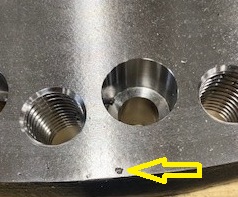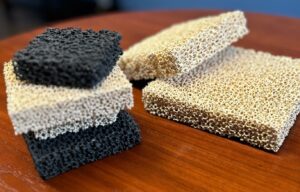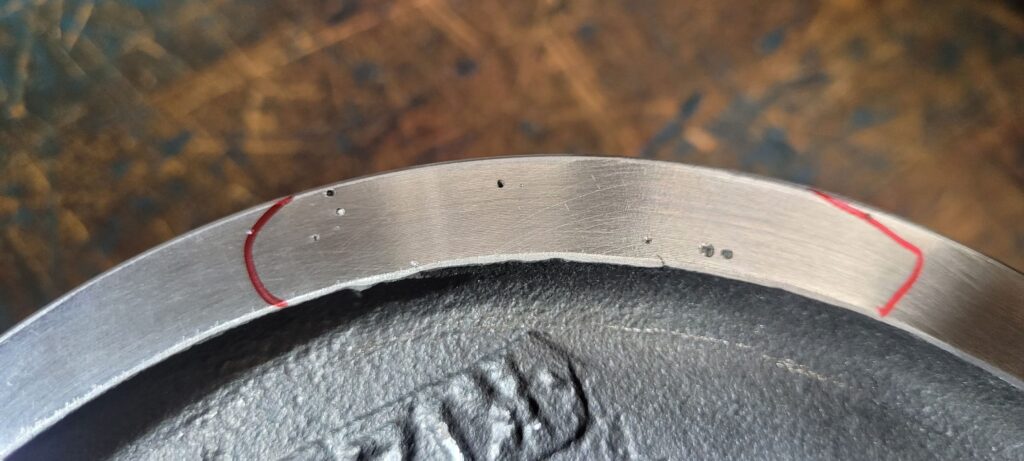Castings can, and likely do, contain porosity at least to some degree. What’s important to understand is how we can control the severity and location of the potential defect and the effect on the final part’s design and function.
Background
Porosity is a natural—and sometimes unavoidable—aspect of the metal casting process. Tiny voids or gas pockets can form when metal solidifies, and while small amounts of porosity are often acceptable, excessive or poorly located porosity can compromise strength, fatigue life, pressure integrity, or even the cosmetic appearance of a finished part.
Porosity in castings generally falls into two categories:
- Gas porosity – Entrapped gases (hydrogen in aluminum, for example) can form bubbles as the molten metal cools. Poor venting in the mold or excessive moisture in the sand can introduce water vapor or air.
- Shrinkage porosity – As metal solidifies it shrinks. If insufficient liquid metal is available to feed that shrinkage, voids will form, especially in the last-to-freeze areas.
Other factors such as turbulence during pouring, improper gating design, or alloy chemistry can exacerbate both gas and shrinkage porosity.
Why Porosity Matters
Even small internal voids can lead to:

- Reduced mechanical strength – voids act as stress concentrators, lowering tensile and fatigue strength.
- Leak path formation – in pressure-containing parts (hydraulic valves, pipe fittings), through‑porosity can lead to leaks.
- Surface blemishes – near-surface porosity can collapse during machining, causing cavities or sink marks.
- Customer perception – visible porosity can undermine confidence in quality, even if it’s structurally benign.
Because of these potential impacts, modern foundries take a multi‑pronged approach to keep porosity in check.
Foundry Strategies to Control Porosity
Porosity can be addressed and controlled at the design and process levels.
Design‑Level Controls
- Optimized Gating & Risering – Proper gate size and location minimize turbulence (reducing gas entrainment) and ensure a steady feed of liquid metal to compensate for shrinkage. Properly‑placed and designed risers (feeders) act as reservoirs of molten metal, filling in areas as they solidify.
- Wall‑Section Uniformity – Designing consistent cross‑sections helps metal cool uniformly, reducing hot spots that tend to form shrinkage voids. Avoiding abrupt thickness changes prevents localized shrinkage porosity.
Process‑Level Controls

- In‑line ceramic filters trap non‑metallic inclusions and help break up gas bubbles.
- Rotary degassers or vacuum degassing remove dissolved hydrogen (notably in aluminum alloys), reducing gas‑induced voids.
- Melt Chemistry Management – Strict control of alloy additions and scrap content keeps hydrogen pickup low and ensures consistent solidification behavior.
- Controlled Pouring Practices – Automated, closed‑ladle pouring systems maintain a calm, laminar flow.
- Preheating materials and ladle equipment prevent moisture reduce gas evolution.
Advanced / Post-Processing Techniques Used to Control Porosity
- Pressure Casting – Applying pressure during solidification (i.e. low-pressure permanent mold, die casting, or squeeze casting) collapses incipient voids and yields near‑fully dense castings. (This is not possible with sand casting.)
- Vacuum Casting – Drawing a vacuum on the mold cavity during pouring removes air and volatiles, virtually eliminating gas porosity.
- Hot Isostatic Pressing (HIP) – Post‑cast HIP treatments subject parts to high temperature and isostatic pressure, closing internal voids and healing micro‑cracks.
- Impregnation – Low‑viscosity resins can seal fine surface‑connected porosity in ready‑to‑ship castings, improving pressure integrity and surface finish.
Inspection
- Non‑Destructive Testing (NDT) – X‑ray or CT scanning can pinpoint porosity distribution and severity before machining or delivery.
- Pressure Testing & Leak Check – Critical for hydraulic or pressure‑vessel components to ensure no through‑porosity.
Porosity is a fact of life in metal-casting, but with thoughtful design, tight process controls, and the right approach, foundries can ensure that porosity is managed to routinely produce high‑integrity, porosity‑controlled components.
Specify cast components with confidence; partner with a foundry that understands these controls so that the effects of porosity can be minimized and part performance maximized.
